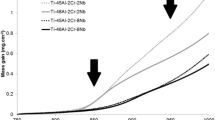Abstract
This work describes the deliberate doping of high purity (99.9999 %) aluminum with titanium (99.8 %) impurity and the effect of this on the temperature of the aluminum liquid–solid phase transition (660.323 °C). The aluminum sample was in the form of an ~0.3 kg ingot (that would normally be used to realize an ITS-90 fixed point) which was doped at ~0.9 ppmw Ti and ~1.8 ppmw Ti (mass fraction in parts per million by mass). Measurements were made with procedures and equipment normally used in a metrological thermometry laboratory, rather than using special arrangements. Samples cut from the aluminum ingot were chemically analyzed by glow discharge mass spectrometry (GD-MS) before doping and after the second doping (to 1.8 ppmw). The experimental temperature offsets were compared with those calculated by interpolation from a reference book value using the mass of dopant introduced, or the chemical analysis data. The results showed that the aluminum temperature increased after adding 0.9 ppmw Ti, but apparently the temperature did not change after further doping to 1.8 ppmw Ti; which was unexpected. The first result suggested that titanium impurity increases the Al transition temperature by +5.1 mK · ppmw−1. However, using the (total) temperature offset and the GD-MS value for the (total) added Ti impurities, then one calculates a value of 3.4 mK · ppmw−1 (much closer to a reference book value). The experimental undoped liquid–solid transition curves were also compared against theoretical curves (calculated using a theoretical model “MTDATA”). This suggested that GD-MS may not be “exposing” all the active impurities (some of which may be “hidden” in the carbon background).
Similar content being viewed by others
References
Ripple D., Fellmuth B., Groot M. de, Hermier Y., Hill K.D., Steur P.P.M., Pokhodun A., Matveyev M., Bloembergen P.: CCT/05-08: Methodologies for the estimation of the uncertainties and the correction of fixed-point temperatures attributable to the influence of chemical impurities. BIPM, Sèvres Cedex, France (2005)
Hansen M.: Constitution of Binary Alloys, 2nd edn. McGraw-Hill, New York (1958)
Ancsin J.: Metrologia 40, 36 (2003)
Head D.I., Davies H., Gray J., Quested P.: Int. J. Thermophys. 29, 1796 (2008)
Davies R.H., Dinsdale A.T., Gisby J.A., Robinson J.A.J., Martin S.M.: CALPHAD 26, 229 (2002)
Rudtsch S., Fahr M., Fischer J., Gusarova T., Kipphardt H., Matschat R.: Int. J. Thermophys. 29, 139 (2008)
P. Petchpong, D.I. Head, Int. J. Thermophys. doi:10.1007/s10765-011-1000-4
Author information
Authors and Affiliations
Corresponding author
Rights and permissions
About this article
Cite this article
Petchpong, P., Head, D.I. The Influence of Titanium on the Aluminum Fixed-Point Temperature. Int J Thermophys 32, 1507–1517 (2011). https://doi.org/10.1007/s10765-011-1024-9
Received:
Accepted:
Published:
Issue Date:
DOI: https://doi.org/10.1007/s10765-011-1024-9




